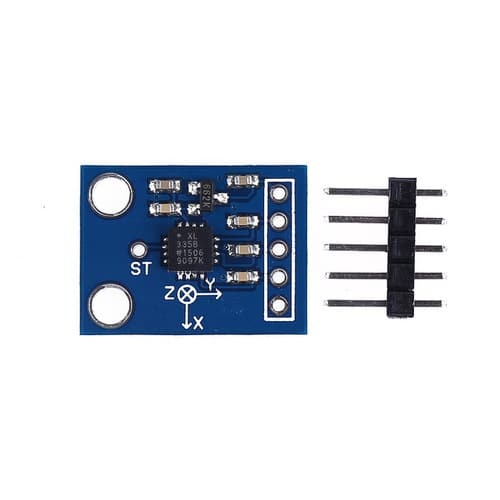Features:
- 3-axis acceleration measurement with analog outputs
- ±3g full-scale range for accurate motion detection
- Adjustable bandwidth via external capacitors
- Low power consumption for battery-powered applications
- High shock resistance: up to 10,000g
- Built-in voltage regulator: compatible with 3.3V–6V supply
- Compact size, lightweight, and Arduino-compatible
Specifications:
| Parameter |
Value |
| Operating Voltage |
1.8V – 3.6V (Sensor), 3.3V – 6V (Module) |
| Operating Current |
350μA (typical) |
| Sensing Range |
±3g |
| Temperature Range |
−40°C to +85°C |
| Sensitivity |
270 to 330mV/g |
| Shock Resistance |
Up to 10,000g |
| Module Dimensions |
4mm x 4mm x 1.45mm |
Pinout:

| Pin |
Name |
Description |
| 1 |
VCC |
Power supply (3.3V to 6V) |
| 2 |
GND |
Ground |
| 3 |
XOUT |
Analog output for X-axis |
| 4 |
YOUT |
Analog output for Y-axis |
| 5 |
ZOUT |
Analog output for Z-axis |
Wiring with Arduino:
| GY-61 Pin |
Arduino Pin |
| VCC |
3.3V |
| GND |
GND |
| XOUT |
A0 |
| YOUT |
A3 |
| ZOUT |
A4 |
Calibration Tips:
- When flat: Z-axis ≈ 1g; X and Y ≈ 0g
- Rotate the sensor to calibrate ±1g and 0g for each axis
Arduino Code Example:
const int xpin = A0;
const int ypin = A3;
const int zpin = A4;
void setup() {
Serial.begin(9600);
}
void loop() {
int x = analogRead(xpin);
int y = analogRead(ypin);
int z = analogRead(zpin);
Serial.print(((float)x - 331.5) / 65 * 9.8); // X-axis in m/s²
Serial.print("\t");
Serial.print(((float)y - 329.5) / 68.5 * 9.8); // Y-axis in m/s²
Serial.print("\t");
Serial.print(((float)z - 340) / 68 * 9.8); // Z-axis in m/s²
Serial.println();
delay(1000);
}
Applications:
- Tilt and orientation sensing
- Motion tracking
- Vibration monitoring
- Robotics and drones
- DIY accelerometer-based control systems
Features:
- 3-axis acceleration measurement with analog outputs
- ±3g full-scale range for accurate motion detection
- Adjustable bandwidth via external capacitors
- Low power consumption for battery-powered applications
- High shock resistance: up to 10,000g
- Built-in voltage regulator: compatible with 3.3V–6V supply
- Compact size, lightweight, and Arduino-compatible
Specifications:
| Parameter |
Value |
| Operating Voltage |
1.8V – 3.6V (Sensor), 3.3V – 6V (Module) |
| Operating Current |
350μA (typical) |
| Sensing Range |
±3g |
| Temperature Range |
−40°C to +85°C |
| Sensitivity |
270 to 330mV/g |
| Shock Resistance |
Up to 10,000g |
| Module Dimensions |
4mm x 4mm x 1.45mm |
Pinout:

| Pin |
Name |
Description |
| 1 |
VCC |
Power supply (3.3V to 6V) |
| 2 |
GND |
Ground |
| 3 |
XOUT |
Analog output for X-axis |
| 4 |
YOUT |
Analog output for Y-axis |
| 5 |
ZOUT |
Analog output for Z-axis |
Wiring with Arduino:
| GY-61 Pin |
Arduino Pin |
| VCC |
3.3V |
| GND |
GND |
| XOUT |
A0 |
| YOUT |
A3 |
| ZOUT |
A4 |
Calibration Tips:
- When flat: Z-axis ≈ 1g; X and Y ≈ 0g
- Rotate the sensor to calibrate ±1g and 0g for each axis
Arduino Code Example:
const int xpin = A0;
const int ypin = A3;
const int zpin = A4;
void setup() {
Serial.begin(9600);
}
void loop() {
int x = analogRead(xpin);
int y = analogRead(ypin);
int z = analogRead(zpin);
Serial.print(((float)x - 331.5) / 65 * 9.8); // X-axis in m/s²
Serial.print("\t");
Serial.print(((float)y - 329.5) / 68.5 * 9.8); // Y-axis in m/s²
Serial.print("\t");
Serial.print(((float)z - 340) / 68 * 9.8); // Z-axis in m/s²
Serial.println();
delay(1000);
}
Applications:
- Tilt and orientation sensing
- Motion tracking
- Vibration monitoring
- Robotics and drones
- DIY accelerometer-based control systems

